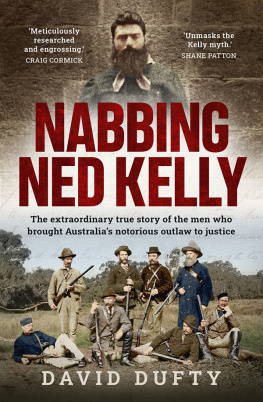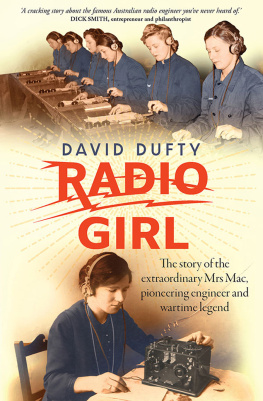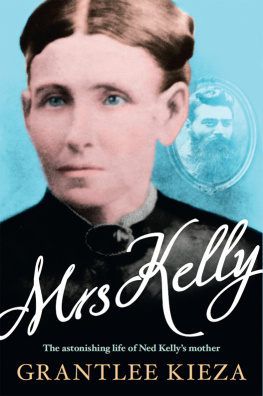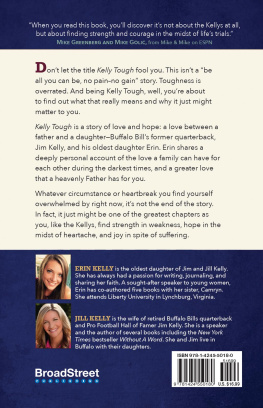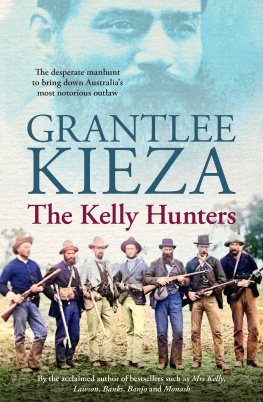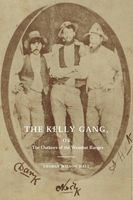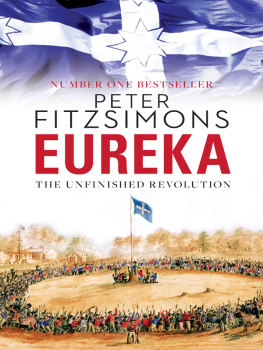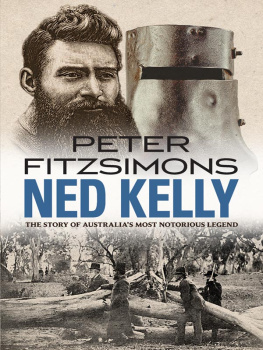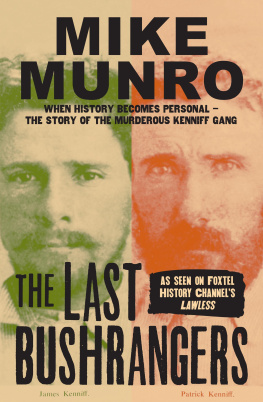
David Dufty is a historian and researcher. He is the author of The Secret Code Breakers of Central Bureau, winner of the 2017 Nib Military History Prize, and of Radio Girl, the story of a pioneering engineer and wartime legend.
First published in 2022
Copyright 2022 David Dufty
All rights reserved. No part of this book may be reproduced or transmitted in any form or by any means, electronic or mechanical, including photocopying, recording or by any information storage and retrieval system, without prior permission in writing from the publisher. The Australian Copyright Act 1968 (the Act) allows a maximum of one chapter or 10 per cent of this book, whichever is the greater, to be photocopied by any educational institution for its educational purposes provided that the educational institution (or body that administers it) has given a remuneration notice to the Copyright Agency (Australia) under the Act.
Allen & Unwin
83 Alexander Street
Crows Nest NSW 2065
Australia
Phone:(61 2) 8425 0100
Email:
Web:www.allenandunwin.com

ISBN 978 1 76106 734 1
eISBN 978 1 76106 399 2
Internal design by Midland Typesetters, Australia
Set by Midland Typesetters, Australia
Cover design: Luke Causby/Blue Cork
Cover photos: Ned Kelly in Melbourne Gaol, 1880, by Charles Nettleton, NLA; the Wangaratta contingent of police at the capture of the Kelly Gang, 1880, by W.E. Barnes, SLVIC; background, Adobe Stock
They laughed and larkd at what theyd done as from the town they turnd,
They rode away like brigands boldthe Kellys, Hart, and Byrne.
They chatter now about police, and say theyre not effective,
But the fear of God is in their hearts of Michael Ward, detective.
Corowa Free Press, 13 June 1879

Ned Kelly was tall, strong, good-looking, charismatic and a formidable hand-to-hand brawler. But he was no hero. A compulsive liar, he was also paranoid and delusional.
Ned was good at crime. He was the architect of a large intercolonial criminal syndicate at a time when police were unaccustomed to dealing with organised crime. He stole cattle, horses, guns and gold. He robbed banks. He murdered. And in the end, he was undone by an insane plan to commit an act of mass murder.
Im sure youve heard the legends about him. That he was an Australian Robin Hood. That the murders he committed were in self-defence. That the bank robberies and kidnappings were merely ploys to raise awareness of police injustice. That the common people supported him because he opposed greedy, rich landholders. But none of those things are true, nor are many other things said about him.
The original idea for this book was to tell the story of the Kelly Gang from the police point of view. It seemed like an intriguing, exciting and overlooked angle on a popular topic. The end resultthe book youre holding nowis still broadly in line with that vision, but it has evolved into a wider investigation of myths and lies. That wasnt the plan, but the deeper I dug, the more it became an imperative.
There was already so much written and said about Kelly; it was overwhelming. How could one person possibly read it all? There have been dozens of books, as well as songs, plays, poems, documentaries, websites and movies. But then came the realisation: all those books, movies, documentaries and so on used the same original source material, so why not start with that? So I initially skipped past all the other books about the Kelly Gang and went right back to basics, studying the original police reports, news coverage and the proceedings of the 1881 Police Royal Commission.
Only after immersing myself in the archival sources, and through them forming my own view of events, did I explore the work of others. That approachof rebuilding the story from its foundationshas led me to question almost everything about the standard historical narrative about the Kelly Gang, and to counter much of what is considered to be fact. The version of events youre about to read here is at odds with most versions youre likely to find elsewhere.
The Kelly outbreak, as it was called at the time, was a cataclysmic event. There was saturation news coverage of everything Kelly-related for more than two years, from the Stringybark Creek murders in 1878 to sometime after Kellys execution in November 1880. The news articles retained by the National Library of Australia are a goldmine of contemporaryand sometimes primarysources. The public records are a wealth of data too: while many aspects of colonial life were rudimentary, Victoria was ahead of other colonies in record-keeping, and consequently there are thousands of pages of official documents, ranging from detective reports to witness affidavits to internal memos, all in the Victorian Public Record Office.
During his reign of terror, Kelly made accusations of police persecution which gained widespread media coverage. In 1881 the Victorian government established a Royal Commission to investigate the causes of the Kelly outbreak and the police response. The Commissioners found no evidence that Kelly or his family were persecuted. Likewise, in searching the various archives 140 years later, I didnt find any evidence of it either. The Royal Commission cross-examined more than 60 witnesses, and the transcripts of those cross-examinations provide fascinating firsthand accounts of events.
Those stories form the backbone of this book, providing a rich cast of characters from every rung of the ladder. At the top is the police commissioner, Captain Standish, a colourful, deeply flawed character with enough redeeming features to make him likeable; vain and inept senior officers; drunk inspectors; taciturn sergeants; and constables who ranged from cowardly to courageous. And in the midst of it all is the Irish-born Detective Michael Ward, unjustly portrayed as a minor villain in Kelly mythology, who was Kellys most dogged and tenacious adversary.
When I eventually delved into the subgenre known as Kellyana, I discovered that modern retellings of the Ned Kelly story dont much resemble the narrative that emerges from the archival documents. In some cases, it appears that historians have wilfully distorted the historical picture. Most astonishing was my discovery that Ned Kelly himself has been used as a primary historical source.
For example, most versions of the Kelly story feature Kellys stepfather, George King, as his partner in crime for a string of robberies. Thats what Ned claimed. Yet there is no mention of George King in any newspaper of the day or in archival records, other than a mention of his marriage to Neds mother, Ellen, in 1874. The local police had not even heard of him. He seems to have just disappeared, if he existed at all. George King does not feature in this book.
In one of his famous Ned Kelly Series paintings, Sidney Nolan depicted Constable Fitzpatrick with his arm seductively around Neds sister Kate, with Neds figure seen outside through the window. Nolan commented on the historical basis of the artwork, saying, The action looks a little comic but it began the real trouble. Since he was an artist rather than a historian, Nolan can be forgiven for believing that falsehood. There are varying accounts of the young policemans seduction of Kate, but theyre all wrong. Not only is there no evidence for it, Ned Kelly himself denied that it happened.
Next page
